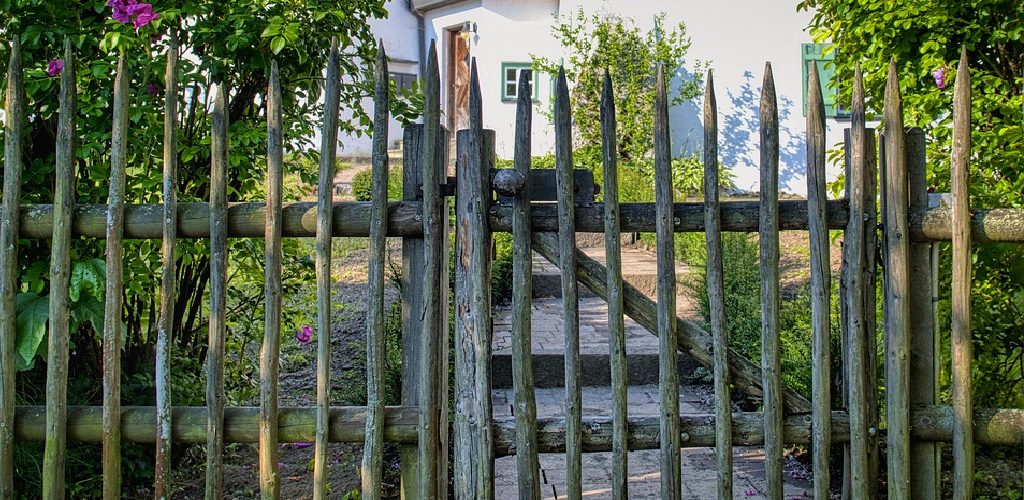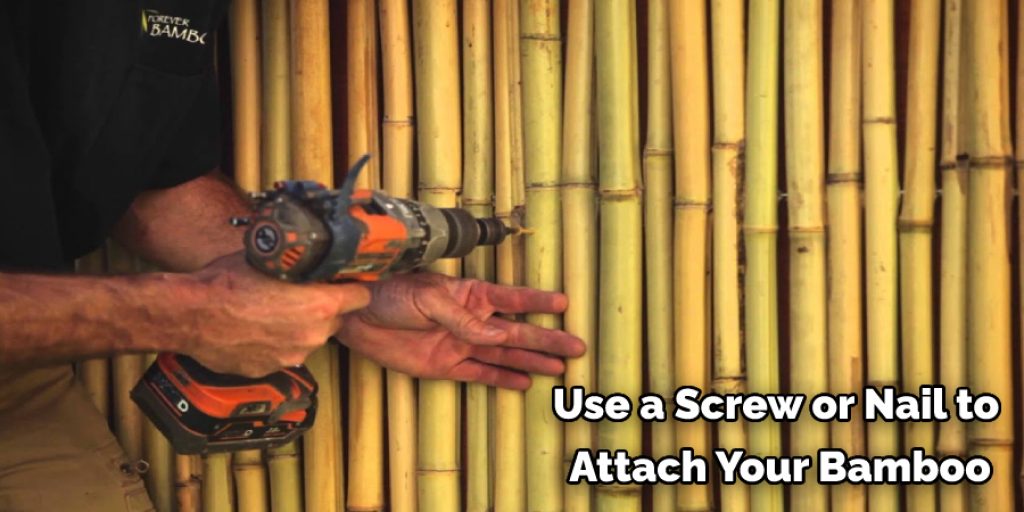How to Cut Bamboo Fencing
Bamboo is a versatile plant that can be used in many ways. It’s also one of the most sustainable and eco-friendly building materials to use for fencing, as it overgrows and requires little maintenance. But how to cut bamboo fencing? Well, we’ll talk about that here!

Fencing made from bamboo is typically split into three sections: posts (the vertical pieces), rails (the horizontal parts), and pickets (the thinner pieces). The length will vary depending on the height you want your fence to reach; usually, they’re between five and six feet long. You should leave at least an inch or two between each piece for splitting purposes.
What is Bamboo Fencing?
Bamboo fencing is a type of fence made from bamboo, which has been used for centuries in Asian countries for building and construction. It is becoming increasingly popular in Western countries due to its sustainability and aesthetic appeal.
Some common types of bamboo fencing include rolled bamboo fencing, live bamboo fencing (where the bamboo is still rooted in the ground), and pre-made bamboo panels. You can also make your own bamboo fencing by cutting and assembling the pieces yourself.
Why cut Bamboo Fencing?
Cutting bamboo fencing is necessary to fit it into your desired space or shape. It’s also essential for creating a clean and uniform look for your fence. If you’re using live bamboo, cutting is a crucial part of the harvesting process. You’ll need to cut the bamboo stalks at specific nodes to ensure proper regrowth and growth patterns.
It’s also important to cut bamboo fencing carefully to avoid splinters and uneven edges, as bamboo can be sharp if not cut correctly. But don’t worry; we’ll walk you through the steps for cutting bamboo fencing safely and effectively. It’s a relatively straightforward process that can be done with a few simple tools. You don’t need to be a professional carpenter to cut bamboo fencing; anyone can do it with the right technique.
Tools You Will Need
To cut your bamboo fencing, you will need the following tools:
Measuring Tape:
This tool will help you measure the length of bamboo pieces needed for your fence and ensure that they are evenly spaced.
Saw:
A saw is necessary to cut through the bamboo stalks. You can use a hand saw or a power saw, depending on your preference and availability.
Pliers:
Pliers will come in handy for removing any unwanted nodes or branches from the bamboo stalks before cutting.
Protective Gear:
It’s essential to wear gloves and protective eyewear when handling bamboo, as it can be sharp and may cause splinters.

10 Ways on How to Cut Bamboo Fencing:
1. Use a Skill Saw
A skilled saw can easily slice through the cane. Just make sure you wear protective eyewear and clothing as small pieces will fly off here and there (ouch). Also, be sure to measure twice before cutting. This method may take longer than 20 minutes, depending on the size of your fence. You may want to use this method if you’re cutting larger pieces of bamboo for your fence. It’s more efficient and precise.
2. Use a Chainsaw
If you have a chainsaw, this is an easy way to cut bamboo fencing. Just remember that safety precautions should be taken before doing so. A chainsaw can get through any bamboo cane in no time but might leave some jagged edges. You may want to sand them down. But if you’re not a perfectionist, this may be an excellent option for you. It’s also handy if you have a lot of bamboo to cut.
3. Use an Axe
An ax can quickly chop through bamboo canes, but it can be strenuous. Be sure to wear gloves and protective eyewear when using this method. If you do not have an ax, a hand saw can be used instead. This method might be better for smaller pieces of bamboo or if you have a limited amount to cut. You can also use an ax to shape the ends of the bamboo for a more decorative look.
4. Drill Many Holes and Cut Through the Cane
This method is time-consuming and requires patience as you drill holes and then cut through each one of them. Be sure to wear protective eyewear and gloves for this method. A word of caution: if the bamboo is too thick, it might be difficult to drill through. So, this method may not be suitable for thicker bamboo pieces.
5. Use a Hammer and Chisel
You can easily cut bamboo fencing if you have a hammer and chisel. This is a slower process, but it can also be quite effective. This will not work on bamboo canes that are too thick. Be sure to wear protective eyewear and gloves for this method. You can also use this method to create unique designs and patterns on the bamboo.
6. Use Metal Shears or Scissors

Metal shears or scissors can effectively cut through bamboo fencing to make the fence fall flat. This is a quick and easy way to cut the fencing, but it might not be as clean of a cut as you would like. Be sure to wear protective eyewear and gloves when using this method. It’s best to use this method for smaller pieces of bamboo or if you’re working on a delicate project.
7. Use a Sawzall
A Sawzall can quickly cut through bamboo fencing with little effort. Just be careful when using this tool, as it can easily cut through your fingers if you’re not careful. Be sure to wear protective eyewear and gloves for this method. This method is suitable for larger pieces of bamboo fencing, as the Sawzall blade can easily get through thicker stalks.
8. Use an Electric or Gas-Powered Chain Saw
This is a quick way to cut bamboo fencing, but it requires an electric or gas-powered chain saw. The downside with using one of these is that they are heavy, so it might be hard to cut through the fencing if you’re not strong enough. Be sure to wear protective eyewear and gloves when using this method. It’s best to use this method for larger pieces of bamboo fencing.
9. Use a Wood Chipper
If you have access to a wood chipper, this is an easy way to chop up your bamboo fencing. The downside to this is that it might be difficult to find one of these machines, and they can be pretty expensive to rent from a home improvement store. Be sure to wear protective eyewear and gloves when using this method. It’s best to use this method if you have a large amount of bamboo fencing to cut.
10. Use the Green Method
This method is easy and doesn’t require any equipment other than having water nearby. Just place the fencing in between two boards (so it’s easier to hold), and then use a water hose to slowly cut through the cane while using sand or a similar abrasive to help. This will take a while, but it’s the easiest way to go green and not use any electricity or gas. Also, the cuts will be as clean or cleaner than what you can get with a saw.
Following these methods will help you cut your bamboo fencing with ease. Remember to take proper safety precautions and measure carefully before cutting. With the right tools and techniques, anyone can successfully cut bamboo fencing for their next project. So, go ahead and start creating your very own unique bamboo fence! Happy fencing!
Some Tips and Suggestions:
1. Always wear protective gear when working around electrical tools.
2. Use a handsaw to cut the bamboo. Do not use any other method as this could make you lose control of the saw and injure yourself.
3. Measure out your desired length for your piece of bamboo before cutting it. This will save you some time, effort, and material if you miscalculated or do not want to waste any material.
4. Apply pressure to the handsaw as you cut to make the process easier and faster.
5. If you are cutting a huge piece of bamboo, it is best to have someone help you as it can be challenging to hold and cut the bamboo all at once.
6. Once you have finished cutting the bamboo, there will be a visibly noticeable cut on the bamboo. Do not worry about it and continue doing your work.
7. Once you have finished all of your cuts, take sandpaper (coarse) and roughen up the ends of the bamboo to prevent any splinters from sticking out that can hurt yourself or someone else. This is optional but strongly advised.
8. If you plan to use a screw or nail to attach your bamboo, it is best to drill in the hole and use a countersink bit so that it does not leave scratches in the bamboo and looks cleaner and more professional when done correctly. This, too, is optional but strongly advised.

Things to Avoid:
- Do not cut with your left hand if you are right-handed or vice versa.
- Do not work in a messy environment as this could cause accidents and injuries.
- Never touch the blade of an ax, handsaw, chainsaw or sawzall, etc., if it is spinning/rotating as this will cause serious injuries to yourself. Make sure the tool is turned completely off and unplugged when changing blades, as well.
- Do not cut bamboo with dull blades as this will make it harder to cut and can cause accidents.
- Do not try to cut a thicker piece of bamboo that you cannot safely handle. This will only lead to frustration, wasted time, energy, and material.
- Do not cut without proper eyewear and gloves as this could result in serious injuries to yourself.
- Do not perform any of these methods if you are under the age of 18 or unsupervised by an adult, as these tools can be dangerous if not used correctly. Safety first!
- Do not use any of these methods on bamboo that has been treated or coated with chemicals, as it can release harmful fumes when cutting.
- Avoid cutting bamboo in windy conditions, as it can be difficult to control and may result in an uneven or unsafe cut.
- Do not forget to clean up after you have finished cutting your bamboo fencing to avoid any accidents or injuries from stepping on leftover pieces of bamboo or tools.
Now that you have learned how to cut bamboo fencing, go ahead and start on your next project with confidence. With proper safety precautions and the right tools, cutting bamboo can be a fun and satisfying experience. So, get those creative juices flowing and see what amazing things you can create using bamboo!
Frequently Asked Questions:
Q: Can I Cut Bamboo Fencing With Scissors?
A: While it is possible to cut bamboo fencing with scissors, it may not be the most efficient method. Scissors can easily get dull and are not designed for cutting thicker materials like bamboo. You may want to consider using a more heavy-duty cutting tool, such as shears or a saw. It is important to always wear protective gear when using any cutting tool.
Q: How Big Should I Cut My Bamboo Pickets?
A: The size of your bamboo pickets will depend on personal preference and the design of your fence. Typically, pickets are between ⅜ to ½ inch in diameter and 5-6 feet long. It is important to leave enough space between each picket for splitting purposes. You can also use a handsaw to trim any excess length if needed. You can also use sandpaper to smooth out any rough edges after cutting. It is always a good idea to measure and plan out your cuts before making them.
Q: Can I Use Bamboo Fencing as a Privacy Screen?
A: Yes, bamboo fencing can be used as a privacy screen by placing it close together and attaching it securely to posts or an existing structure. However, keep in mind that bamboo fencing is not completely opaque and may still allow some visibility. You can also add additional layers or materials for added privacy if desired. Be sure to follow any local regulations regarding fence height and placement. You may also want to consult with your neighbors before installing bamboo fencing as a privacy screen.
Q: How Do I Cut Bamboo Fencing Without Splintering?
A: To prevent splintering when cutting bamboo fencing, it is best to use a sharp cutting tool, such as a handsaw or shears. Additionally, securing the bamboo between two boards can help keep it in place and prevent splintering. Using sandpaper to smooth out any rough edges after cutting can also help prevent splinters. It is also important to cut slowly and carefully to avoid putting too much pressure on the bamboo, which can cause it to splinter. Lastly, using a protective sealant or coating on the cut ends of the bamboo can also help prevent splintering in the long run.
Q: What Are Some Alternative Uses for Bamboo Fencing?
A: Besides being used as a fence, bamboo fencing can also be repurposed for other projects such as creating privacy screens on balconies or patios, building trellises or pergolas, and even making furniture or decor items. It can also be used in gardening and landscaping projects to create natural barriers or supports for plants. The versatility of bamboo makes it a great eco-friendly material for various DIY projects. Always make sure to properly cut and prepare the bamboo before using it in any project. Remember to also dispose of any leftover or unused bamboo responsibly.
Q: Can I Cut Bamboo Fencing at an Angle?
A: Yes, you can cut bamboo fencing at an angle using a handsaw or shears. This may be necessary if you are creating a fence on uneven ground or have a specific design in mind. It is important to measure and mark the desired angle before cutting to ensure accuracy and avoid any mistakes. You may also want to use a vise or clamp to secure the bamboo in place while cutting at an angle. Remember to always wear protective gear and take caution when cutting at an angle.
Conclusion:
Cutting bamboo fencing can be a tricky task. However, with the right tools and some patience, you should be able to cut it quickly and easily. You first need a long-handled saw with a sharp blade for cutting wood or metal. This tool will help you make clean cuts in your fence without bending over too much.
Next, measure out how far apart from each other you want the slats of your new fence to be placed before starting any work on them, so they are uniform throughout the length of the project. Then start at one end of the area where you wish to install this type of fencing by inserting your knife into an open space between two existing slats near ground level. We hope this blog post on how to cut bamboo fencing has been helpful. Let us know your thoughts in the comments below!
You Can Check It Out To Cut the Cardboard in a Beret




